Lisa Sachs's Blog, page 9
January 14, 2016
How Pres. Obama's State of the Union Address Sends Me Time Traveling
The State of Our Union is polarized. Are we at the breaking point? Have we become ungovernable? In President Obama’s eighth and, unfortunately last, State of the Union Address, he expressed this as his largest regret as president. “It’s one of the few regrets of my presidency that the rancor and suspicion between the parties has gotten worse instead of better,” he said.
President Obama went on to suggest several ways that the electoral process needed to be changed to ensure that our current state of polarity be reigned in. I can think of several other steps that need to be taken that he didn’t discuss especially abolishing the Electoral College but that could be the subject of a whole posting of its own. In the meantime, polarized we are. In his parting State of the Union address, President Obama looking to the future, warned us of the consequences of all our animosities to one another. He counseled us to have rational debates, to listen to each other without vehemence, and to make sure that every citizen has the opportunity to have a voice in our political process imploring us all to participate as citizens. We would all do well to heed his words as we go forward.
Pres. Obama’s message was exquisitely stated and brought me back to an earlier time when things in America were simpler and people got along with each other with more civility. Although that is how that time period is perceived in America’s collective consciousness, the 1950’s and 1960’s were not really that peaceful an era. In fact, it was the height of the Cold War, McCarthyism, and the House Un-American Activities Committee.
I wish that I could forget the air-raid drills we had periodically in my elementary school and high school. I wish that I could forget crouching under my desk in my classroom with my hands behind my head as if this would save me and my classmates in the event of a thermonuclear attack. Most of all, I wish that I could forget the nightmares that I had about surviving one of them. When I’d wake my parents after one of my nightmares, they’d tell me it wouldn’t happen. I’d ask them if that was the case why they had to demonstrate and attend meetings of Sane (the Committee for a Sane Nuclear Policy). I still remember their campaign buttons. “There’s still time, Brother.” In high school, I enjoyed telling friends that my parents were in Sane, but I was still having the nightmares.
In a moment of national unity, President Eisenhower addressed the American public farewell on January 17, 1961. Although I was only 13 years old, I remember watching Pres. Eisenhower deliver that speech. “Beware of the military-industrial complex.” As a military man, he was especially versed in what the military was and leaving office, he had that advice to Americans looking toward the future. If only we’d heeded his advice, we’d be in better shape today. I hope that there’s still time, Brother, to listen to him now.
President Obama went on to suggest several ways that the electoral process needed to be changed to ensure that our current state of polarity be reigned in. I can think of several other steps that need to be taken that he didn’t discuss especially abolishing the Electoral College but that could be the subject of a whole posting of its own. In the meantime, polarized we are. In his parting State of the Union address, President Obama looking to the future, warned us of the consequences of all our animosities to one another. He counseled us to have rational debates, to listen to each other without vehemence, and to make sure that every citizen has the opportunity to have a voice in our political process imploring us all to participate as citizens. We would all do well to heed his words as we go forward.
Pres. Obama’s message was exquisitely stated and brought me back to an earlier time when things in America were simpler and people got along with each other with more civility. Although that is how that time period is perceived in America’s collective consciousness, the 1950’s and 1960’s were not really that peaceful an era. In fact, it was the height of the Cold War, McCarthyism, and the House Un-American Activities Committee.
I wish that I could forget the air-raid drills we had periodically in my elementary school and high school. I wish that I could forget crouching under my desk in my classroom with my hands behind my head as if this would save me and my classmates in the event of a thermonuclear attack. Most of all, I wish that I could forget the nightmares that I had about surviving one of them. When I’d wake my parents after one of my nightmares, they’d tell me it wouldn’t happen. I’d ask them if that was the case why they had to demonstrate and attend meetings of Sane (the Committee for a Sane Nuclear Policy). I still remember their campaign buttons. “There’s still time, Brother.” In high school, I enjoyed telling friends that my parents were in Sane, but I was still having the nightmares.
In a moment of national unity, President Eisenhower addressed the American public farewell on January 17, 1961. Although I was only 13 years old, I remember watching Pres. Eisenhower deliver that speech. “Beware of the military-industrial complex.” As a military man, he was especially versed in what the military was and leaving office, he had that advice to Americans looking toward the future. If only we’d heeded his advice, we’d be in better shape today. I hope that there’s still time, Brother, to listen to him now.
Published on January 14, 2016 06:00
January 7, 2016
Viewing Racism At the Art Institute
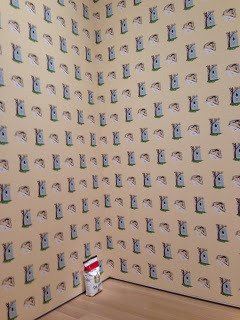 Untitled by Robert Gober
Untitled by Robert Gober
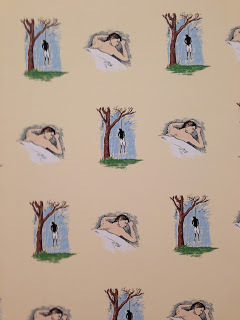 Untitled by Robert Gober a closeup The good news is that Chicago is no longer the most segregated large city in America. According to the January 4th Chicago Tribune, it is now only the 3rd most segregated large city -behind Milwaukee and New York.
Untitled by Robert Gober a closeup The good news is that Chicago is no longer the most segregated large city in America. According to the January 4th Chicago Tribune, it is now only the 3rd most segregated large city -behind Milwaukee and New York.Progress is being made here albeit at a snail's pace.
Since the Art Institute in Chicago was expanded, they've had room for even more works of art and so the collection shown is even more impressive than it was. It's worth a visit even more than before. While their Impressionist collection is outstanding, sometimes it's good to branch out and see something else.
We saw the above painting which is located in the contemporary wing of the museum and is called "Untitled." It was painted by Robert Gober born in 1954. He says that "...the painful imagery was meant as a reminder of fact - the ugly and unforgettable reality of United States history." It's a new concept - racism and lynchings as wallpaper as white America sleeps comfortably for the most part ignoring it. His painting is saying that racism in America is like wallpaper- ubiquitous and therefore, something we are numb to and tend to ignore.
The year 2015 was a ghastly one for police over-reaction against African-Americans. This was true not only in Chicago, but also in many other American cities. Since the police are part of American society, we have probably all been guilty of the same types of over-reactions. Unfortunately, the police have guns and the opportunity for their over-reactions to be deadly. While the police especially need to be trained to be aware of their racist feelings so that they can know how to stop acting on those feelings in the line of duty, most of white America would do well to have that training. We have to stop over-reacting. I hope that 2016 is a year in which we begin to address the racism that is embedded in our society as we take an honest look at our own reactions.
A good place to start is at the Art Institute. Go to the contemporary wing to see "Untitled" by Robert Gober. A picture is worth a thousand words and a good place to start this journey.
Published on January 07, 2016 06:00
December 31, 2015
Good-bye 2015!
Growing up in New York, I always knew the year had ended when the ubiquitous ball dropped in Times Square. Even now, although I've lived in the Chicago area for over 40 years, that event still seems to make the new year official. This year I can't wait until then to wish everyone a happy, healthy, peaceful new year. All I can hope is that 2016 proves to be calmer, more peaceful, less violent, less desperate for everyone around this beautiful world of ours. This Earth is the only one we all call home and we have to do a better job of caring for it and sharing it with one another.
In that spirit, I want to say Good-bye 2015!
Good-bye to terrorist attacks.
Good-bye to indiscriminate use of violence by police against minorities in United States cities and towns especially Chicago which has been my home since 1974.
While we're at it, good-bye to gang violence and the death of innocent civilians by each other.
Good-bye to the need for people to flee war-torn countries in the Middle East and Africa.
On a personal level, my husband and I enjoy good health as do our children and grandchildren. Some of our friends and family do not and I hope the new year brings less stress and more calm.
One good thing that happened is that my book Breaking the Fall is now available on Amazon as a Kindle and a paperback. I'll be talking more about that in the year ahead.
To all of you, happy 2016. May we all enjoy a happy, healthy, and calm New Year!
Published on December 31, 2015 08:32
December 24, 2015
Learning About Never Again in Skokie, Illinois
Never Again! Not to Jews, not to people in the Middle East, Eastern Europe, Africans or anyone else. But can it be happening again? With the current rise in anti- Muslim hatred and Trump's extremist proposals, there’s a palpable fear in the air that it could.
With that in mind, we visited the Illinois Holocaust Museum in Skokie, Illinois (www.ilholocaustmuseum.org). Skokie, an adjacent suburb of Chicago, was once the home to the largest concentration of Holocaust survivors in the United States. Out of a population of 70,000, 7,000 were Holocaust survivors and their families. The survivors, knowing that they were blessed beyond measure to still be alive, felt that their mission was to educate future generations about what happened. The current museum opened in 2009.
We’d been to the National Holocaust Museum in Washington, D.C. and to Terezin, the transit camp just outside of Prague. Both of these sites have extremely powerful messages. Somehow, however, the Skokie Holocaust Museum exhibit was much more personal. It was personal to see pictures and videos of interviews of people my husband had known growing up. Some of them had never spoken about their experiences to him. Many had never talked about the Holocaust at all. After Neo-Nazis marched in Skokie in 1978, the Survivor community realized that they had to share their experiences before they passed away so that people coming after them would know what happened.
As we entered the Museum, we had to pass through a metal detector and were told that photographs were forbidden. Thus, I have no pictures of the exhibit to share with you. The permanent exhibit does a great job of showing the rise of Nazism, the way Jews throughout Europe slowly lost everything, how they were herded into ghettoes, and then the Concentration Camp experience itself. They showed the Jewish uprisings in the ghettoes and what happened to the survivors after the War.
What particularly resonated with me was seeing that as Hitler rose to power, many people- Jews included -dismissed him as a comical man who couldn’t possibly be taken seriously. It felt very much the same as the reaction I’ve had to Donald Trump and his proposals about Moslems. It sent a chill down my spine. Many Jews didn’t realize until it was too late that they needed to leave Europe. By the time they realized it, many couldn’t get out.
There is a part of the exhibit toward the end showing how many people in each of the countries of Europe collaborated with the Nazis either actively or by failing to speak up against them. It was a moment that the world went mad. It could happen again.
At the end of the exhibit, there's a short film with some of the Survivors telling their stories. At the end, they leave us with this caveat:
Now I have told you my story. The rest is up to you.
That says it all. Now it’s up to you to go see this powerful exhibit.
With that in mind, we visited the Illinois Holocaust Museum in Skokie, Illinois (www.ilholocaustmuseum.org). Skokie, an adjacent suburb of Chicago, was once the home to the largest concentration of Holocaust survivors in the United States. Out of a population of 70,000, 7,000 were Holocaust survivors and their families. The survivors, knowing that they were blessed beyond measure to still be alive, felt that their mission was to educate future generations about what happened. The current museum opened in 2009.
We’d been to the National Holocaust Museum in Washington, D.C. and to Terezin, the transit camp just outside of Prague. Both of these sites have extremely powerful messages. Somehow, however, the Skokie Holocaust Museum exhibit was much more personal. It was personal to see pictures and videos of interviews of people my husband had known growing up. Some of them had never spoken about their experiences to him. Many had never talked about the Holocaust at all. After Neo-Nazis marched in Skokie in 1978, the Survivor community realized that they had to share their experiences before they passed away so that people coming after them would know what happened.
As we entered the Museum, we had to pass through a metal detector and were told that photographs were forbidden. Thus, I have no pictures of the exhibit to share with you. The permanent exhibit does a great job of showing the rise of Nazism, the way Jews throughout Europe slowly lost everything, how they were herded into ghettoes, and then the Concentration Camp experience itself. They showed the Jewish uprisings in the ghettoes and what happened to the survivors after the War.
What particularly resonated with me was seeing that as Hitler rose to power, many people- Jews included -dismissed him as a comical man who couldn’t possibly be taken seriously. It felt very much the same as the reaction I’ve had to Donald Trump and his proposals about Moslems. It sent a chill down my spine. Many Jews didn’t realize until it was too late that they needed to leave Europe. By the time they realized it, many couldn’t get out.
There is a part of the exhibit toward the end showing how many people in each of the countries of Europe collaborated with the Nazis either actively or by failing to speak up against them. It was a moment that the world went mad. It could happen again.
At the end of the exhibit, there's a short film with some of the Survivors telling their stories. At the end, they leave us with this caveat:
Now I have told you my story. The rest is up to you.
That says it all. Now it’s up to you to go see this powerful exhibit.
Published on December 24, 2015 07:46
December 17, 2015
Standing Together Against Islamaphobia
It was reassuring to see that hundreds of people of many faiths stood united in Evanston against Islamaphobia in Fountain Square the night of December 15th. There are many reasons for me to be concerned about the rising tide of hatred against Muslims. One of many reasons that I feel affected by this development has been my volunteer work with immigrants and refugees some of whom are Muslims. I've heard their stories and learned about the cultures from which they came. The experience of sharing has enriched my life. I feel that are lives are all made better by meeting and learning from each other.
Another reason is that for me as an American Jew, it feels wrong for this country of immigrants to be against immigration. It does not promote justice and is against everything our better selves stand for. Except for the Native Americans, all of us or someone in our families came from somewhere else at some point. There are only about 5.2 million Native Americans left in the United States. That leaves about 325 million of us whose families were originally immigrants.
My great-grandparents and grandparents left Russia and Hungary fleeing anti-Semitic pogroms. If immigration laws and quotas had been in existence at that time, I wouldn’t be here now. Thanks to the first Amendment of the United States Constitution, we have Separation Between Church and State and my ancestors were given safe shelter here for which they were always grateful. Now political leaders such as Jeb Bush, Ted Cruz, and Donald Trump are suggesting that we only let Christian Syrians enter the United States. Will they think about kicking me out next? The whole prospect is extremely frightening.
America has done better than it’s doing now as far as immigration is concerned. That’s why we have people from so many different countries living here enriching each other’s lives. We’ve had our moments of shame as well. The internment of Japanese-Americans during World War II comes quickly to mind. The turning away of the S.S. St. Louis from Miami does as well. I remember my grandmother telling me stories about how her father, my great-grandfather, stood with other Jewish leaders in Miami pleading with the government to let these refugees in promising to take care of them so that they wouldn’t be a burden to society. These efforts were for naught and the refugees were returned to Europe to face the gas chambers. We need to stand up to the forces that want to descend to that level of darkness again.
This moment brings to mind the poem by Martin Niemoller. The son of a pastor, he was born in Lippstadt, Germany in 1892.
And Then They Came for Me
By Martin Niemoller
First they came for the communists, and I did not speak out - because I was not a communist;
Then they came for the socialists, and I did not speak out - because I was not a socialist;
Then they came for the trade unionists, and I did not speak out - because I was not a trade unionist;
Then they came for the Jews, and I did not speak out - because I was not a Jew;
Then they came for me - and there was no one left to speak out for me.
As we confront the rising tide of hatred in our country, let us all keep this poem in mind. We as Americans need to and can do better. It's the best part of who we are.
Another reason is that for me as an American Jew, it feels wrong for this country of immigrants to be against immigration. It does not promote justice and is against everything our better selves stand for. Except for the Native Americans, all of us or someone in our families came from somewhere else at some point. There are only about 5.2 million Native Americans left in the United States. That leaves about 325 million of us whose families were originally immigrants.
My great-grandparents and grandparents left Russia and Hungary fleeing anti-Semitic pogroms. If immigration laws and quotas had been in existence at that time, I wouldn’t be here now. Thanks to the first Amendment of the United States Constitution, we have Separation Between Church and State and my ancestors were given safe shelter here for which they were always grateful. Now political leaders such as Jeb Bush, Ted Cruz, and Donald Trump are suggesting that we only let Christian Syrians enter the United States. Will they think about kicking me out next? The whole prospect is extremely frightening.
America has done better than it’s doing now as far as immigration is concerned. That’s why we have people from so many different countries living here enriching each other’s lives. We’ve had our moments of shame as well. The internment of Japanese-Americans during World War II comes quickly to mind. The turning away of the S.S. St. Louis from Miami does as well. I remember my grandmother telling me stories about how her father, my great-grandfather, stood with other Jewish leaders in Miami pleading with the government to let these refugees in promising to take care of them so that they wouldn’t be a burden to society. These efforts were for naught and the refugees were returned to Europe to face the gas chambers. We need to stand up to the forces that want to descend to that level of darkness again.
This moment brings to mind the poem by Martin Niemoller. The son of a pastor, he was born in Lippstadt, Germany in 1892.
And Then They Came for Me
By Martin Niemoller
First they came for the communists, and I did not speak out - because I was not a communist;
Then they came for the socialists, and I did not speak out - because I was not a socialist;
Then they came for the trade unionists, and I did not speak out - because I was not a trade unionist;
Then they came for the Jews, and I did not speak out - because I was not a Jew;
Then they came for me - and there was no one left to speak out for me.
As we confront the rising tide of hatred in our country, let us all keep this poem in mind. We as Americans need to and can do better. It's the best part of who we are.
Published on December 17, 2015 07:46
December 10, 2015
Fighting the Cold On A Wintry Chicago Day
Chicago has great museums, a magnificent lakefront, fabulous architecture, and many other wonderful attractions. I usually recommend that people visit here between the middle of April to about the middle of November when the weather is pleasant or at least bearable so they can enjoy being outside to see all the great things that Chicago has to offer.
There is a way to enjoy Chicago in the winter, however. I don’t know why the city of Chicago doesn’t give it more publicity. That way is utilizing the Pedway. This system of underground walkways in downtown Chicago is quite extensive connecting many buildings and subway stations to each other. One can use it to navigate a good part of Chicago’s downtown to avoid going outside when it’s too cold or rainy.
The Chicago Architecture Foundation (CAF) at www.architecture.org, which gives about 80 walking tours of various parts of Chicago, gives two walking tours of the Pedway-Pedway East and Pedway West. Since we’d already taken the Pedway East tour, we decided to take the Pedway West tour last week.
Our tour began on the lower level of Block 37 at the Guest Services Desk. This block has gone through many changes but is now being used to house stores, restaurants, an AMC movie theatre, and will soon have a Condo building. Prior to the tour, we ate lunch in the building at Latinicity, a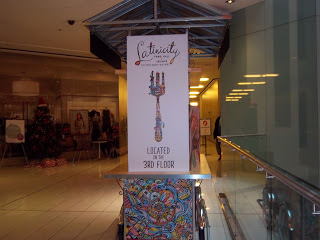
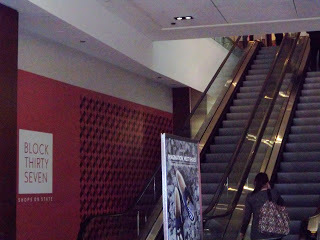 lower level of Block 37 new Latino fusion restaurant. Only open a few weeks, it is already very busy. Word must have gotten out about how good it is.
lower level of Block 37 new Latino fusion restaurant. Only open a few weeks, it is already very busy. Word must have gotten out about how good it is.
After lunch, we met up with the CAF tour. Our docent Roy Slewinski did a great job of ushering us through the labyrinth known as the Pedway. He pointed out the Pedway’s logo that one can see on the walls and use as a guideline to follow throughout the network of walkways. Unfortunately, there aren’t enough of these logos and it would be difficult to find your way relying solely on them. Thinking of everything, Roy provided us with maps of the Pedway. These would be helpful for anyone unfamiliar with it. I think it would be great if the Chicago tourist office handed these maps out to anyone visiting Chicago in the winter.
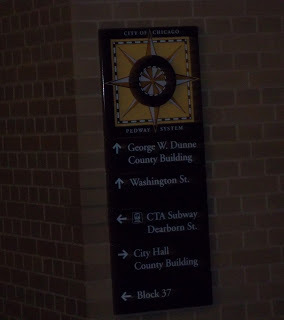 Pedway LogoWalking through the Pedway, we went up to the Richard J. Daley Center, the County Building, the 120 N. LaSalle Building, the Leo Burnett Building, and the James R. Thompson State of Illinois Building and several others. Along the way, we learned something about the architecture and the history of these buildings and about the Pedway itself. It was a cold, rainy day, but who cared? We didn’t have to go outside for any of it.
Pedway LogoWalking through the Pedway, we went up to the Richard J. Daley Center, the County Building, the 120 N. LaSalle Building, the Leo Burnett Building, and the James R. Thompson State of Illinois Building and several others. Along the way, we learned something about the architecture and the history of these buildings and about the Pedway itself. It was a cold, rainy day, but who cared? We didn’t have to go outside for any of it.
 at the Daley Center looking across at the Burnham Center
at the Daley Center looking across at the Burnham Center
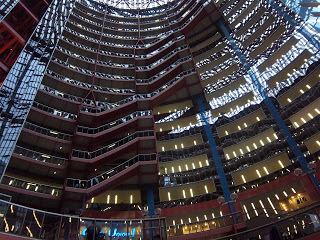 lobby of the State of Illinois Building looking up
lobby of the State of Illinois Building looking up
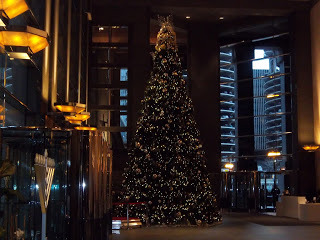 lobby of the Marriott Renaissance Hotel
lobby of the Marriott Renaissance Hotel
The CAF offers the Pedway Tours from October through February. You can check the CAF website for details of their schedule. I highly recommend this tour.
There is a way to enjoy Chicago in the winter, however. I don’t know why the city of Chicago doesn’t give it more publicity. That way is utilizing the Pedway. This system of underground walkways in downtown Chicago is quite extensive connecting many buildings and subway stations to each other. One can use it to navigate a good part of Chicago’s downtown to avoid going outside when it’s too cold or rainy.
The Chicago Architecture Foundation (CAF) at www.architecture.org, which gives about 80 walking tours of various parts of Chicago, gives two walking tours of the Pedway-Pedway East and Pedway West. Since we’d already taken the Pedway East tour, we decided to take the Pedway West tour last week.
Our tour began on the lower level of Block 37 at the Guest Services Desk. This block has gone through many changes but is now being used to house stores, restaurants, an AMC movie theatre, and will soon have a Condo building. Prior to the tour, we ate lunch in the building at Latinicity, a

 lower level of Block 37 new Latino fusion restaurant. Only open a few weeks, it is already very busy. Word must have gotten out about how good it is.
lower level of Block 37 new Latino fusion restaurant. Only open a few weeks, it is already very busy. Word must have gotten out about how good it is.After lunch, we met up with the CAF tour. Our docent Roy Slewinski did a great job of ushering us through the labyrinth known as the Pedway. He pointed out the Pedway’s logo that one can see on the walls and use as a guideline to follow throughout the network of walkways. Unfortunately, there aren’t enough of these logos and it would be difficult to find your way relying solely on them. Thinking of everything, Roy provided us with maps of the Pedway. These would be helpful for anyone unfamiliar with it. I think it would be great if the Chicago tourist office handed these maps out to anyone visiting Chicago in the winter.
 Pedway LogoWalking through the Pedway, we went up to the Richard J. Daley Center, the County Building, the 120 N. LaSalle Building, the Leo Burnett Building, and the James R. Thompson State of Illinois Building and several others. Along the way, we learned something about the architecture and the history of these buildings and about the Pedway itself. It was a cold, rainy day, but who cared? We didn’t have to go outside for any of it.
Pedway LogoWalking through the Pedway, we went up to the Richard J. Daley Center, the County Building, the 120 N. LaSalle Building, the Leo Burnett Building, and the James R. Thompson State of Illinois Building and several others. Along the way, we learned something about the architecture and the history of these buildings and about the Pedway itself. It was a cold, rainy day, but who cared? We didn’t have to go outside for any of it. at the Daley Center looking across at the Burnham Center
at the Daley Center looking across at the Burnham Center lobby of the State of Illinois Building looking up
lobby of the State of Illinois Building looking up lobby of the Marriott Renaissance Hotel
lobby of the Marriott Renaissance HotelThe CAF offers the Pedway Tours from October through February. You can check the CAF website for details of their schedule. I highly recommend this tour.
Published on December 10, 2015 07:30
December 2, 2015
A Pen Pal for Hi-Tech Times
Throughout my junior high, high school, and college years, I had an English pen pal named Irene. She lived in Northern England and we’d write to each other every week. It wasn’t unusual to send each other four and five page letters complete with photos and drawings. Nowadays I can’t even remember the last time I sent someone a letter via snail mail. In fact, it’s unusual to sit down and write anything by hand at all. That’s probably a factor in the decision of many school systems to eliminate cursive writing from their curricula.
While I understand that few people these days –myself included- have the patience to sit down and write, I sometimes miss the passing of those long letters sent through the mail. Wouldn’t it be fun to have a pen pal again in a foreign country. After all, most of us can’t travel all the time and many don’t have the opportunity to travel at all. Our world is getting smaller and it’s fun to connect with people from around the world.
Fortunately, one organization has come up with a modern day equivalent. It’s called www.mylanguageexchange.com. If you sign in, you can find a partner to e-mail with or talk to directly on Skype. They have some group discussions as well. The purpose of this website is to provide an opportunity to practice speaking each other’s language. The website includes people speaking any language looking for a partner speaking any other language.
I have found someone to Skype with who speaks French and lives in Quebec Province. She wants to practice English so that she can talk to people when she goes to Florida in the winter. I want to speak French because I love the language.
Since I’ll probably have more opportunities to speak French to the Quebequois when I visit south Florida than when or if I ever have the opportunity to visit France again, it seemed like a good match. I’m still getting used to her accent and some different word usages. Just as Europeans learn British English, most Americans who study French in school learn Parisian French. Sometimes the change is difficult for me, but I enjoy the challenge. She’s sent me an easy recipe for Crème Caramel. I fully intend to try it. I’ll let you know how it comes out.
While I understand that few people these days –myself included- have the patience to sit down and write, I sometimes miss the passing of those long letters sent through the mail. Wouldn’t it be fun to have a pen pal again in a foreign country. After all, most of us can’t travel all the time and many don’t have the opportunity to travel at all. Our world is getting smaller and it’s fun to connect with people from around the world.
Fortunately, one organization has come up with a modern day equivalent. It’s called www.mylanguageexchange.com. If you sign in, you can find a partner to e-mail with or talk to directly on Skype. They have some group discussions as well. The purpose of this website is to provide an opportunity to practice speaking each other’s language. The website includes people speaking any language looking for a partner speaking any other language.
I have found someone to Skype with who speaks French and lives in Quebec Province. She wants to practice English so that she can talk to people when she goes to Florida in the winter. I want to speak French because I love the language.
Since I’ll probably have more opportunities to speak French to the Quebequois when I visit south Florida than when or if I ever have the opportunity to visit France again, it seemed like a good match. I’m still getting used to her accent and some different word usages. Just as Europeans learn British English, most Americans who study French in school learn Parisian French. Sometimes the change is difficult for me, but I enjoy the challenge. She’s sent me an easy recipe for Crème Caramel. I fully intend to try it. I’ll let you know how it comes out.
Published on December 02, 2015 08:14
November 11, 2015
Saint or Sinner - You Be the Judge
When Lt. (GI Joe) Gliniewicz was murdered in Fox Lake, Illinois, an extensive manhunt was organized to search for him. Thousands of police from all over the United States attended his funeral to pay their respects to this local hero who had mentored so many and been active in helping the Boys’ and Girls’ Clubs in Fox Lake.
After the funeral, many of G.I. Joe’s transgressions came to light. Apparently he committed suicide and had it rigged to look like a murder to hide his crimes. Allegedly, he had been embezzling money from the Boys’ and Girls’ Clubs that he purportedly helped for years. In addition, there had been many other incidents and complaints against him involving sexual harassment, drunkenness on the job, and other violations of the public trust. Does the bad erase all the good that GI Joe did? Was he a saint or a sinner?
The whole controversy surrounding Lt. Gliniewicz’ death brings to mind a trip we took to Argentina in February, 2012. Before leaving, I asked an acquaintance who had grown up in Buenos Aires for ideas about places of interest to see. One of her top recommendations was the cemetery in Ricoleta, a very prominent Buenos Aires neighborhood. Another top recommendation was to go to the Evita Peron Museum.
Prior to our trip to South America, I had always thought of Juan and Eva Peron as dictators who ruled Argentina with iron fists from 1944 to 1952 and caused many of their political opponents to be disappeared and/or imprisoned. The Perons-BAD! The Evita Peron Museum painted a totally different picture. She advocated for labor, women’s rights, the decamisados (the shirtless i.e. poor) and women’s suffrage and is remembered for having single-handedly established a women’s health clinic and organized low-cost housing. Eva Peron was adored by her constituents for this.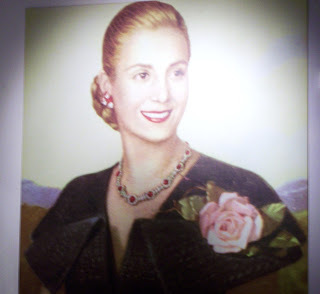 Eva Peron
Eva Peron
The cemetery at Ricoleta is worth a visit to see all its elaborate monuments and could be the blog post subject in itself of many a writer. At Eva Peron’s grave, people are still coming to this day to bring flowers and pay tribute to her. I was surprised to see written on her grave “Don’t cry for me…” I thought it was just a song written for the musical. Does this mean that the Perons were not dictators who had their opponents sent to prison and/or disappeared? Were they saints or sinners? Again, you be the judge.
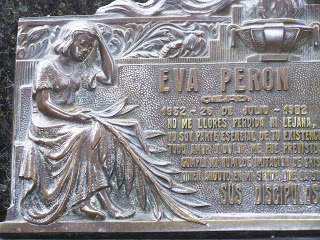 Eva Peron's tombstone
Eva Peron's tombstone
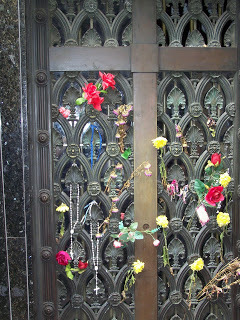 Eva's grave with fresh flowers left by her supporters 50 years later
Eva's grave with fresh flowers left by her supporters 50 years later
For me, the take-home message of that South American trip is that we human beings are very complicated. Few if any among us are all good or all bad. For most people, it is easier to see others in stark black or white than in shades of gray. Yet, that’s who we are. Saints or sinners? Let history be the judge.
After the funeral, many of G.I. Joe’s transgressions came to light. Apparently he committed suicide and had it rigged to look like a murder to hide his crimes. Allegedly, he had been embezzling money from the Boys’ and Girls’ Clubs that he purportedly helped for years. In addition, there had been many other incidents and complaints against him involving sexual harassment, drunkenness on the job, and other violations of the public trust. Does the bad erase all the good that GI Joe did? Was he a saint or a sinner?
The whole controversy surrounding Lt. Gliniewicz’ death brings to mind a trip we took to Argentina in February, 2012. Before leaving, I asked an acquaintance who had grown up in Buenos Aires for ideas about places of interest to see. One of her top recommendations was the cemetery in Ricoleta, a very prominent Buenos Aires neighborhood. Another top recommendation was to go to the Evita Peron Museum.
Prior to our trip to South America, I had always thought of Juan and Eva Peron as dictators who ruled Argentina with iron fists from 1944 to 1952 and caused many of their political opponents to be disappeared and/or imprisoned. The Perons-BAD! The Evita Peron Museum painted a totally different picture. She advocated for labor, women’s rights, the decamisados (the shirtless i.e. poor) and women’s suffrage and is remembered for having single-handedly established a women’s health clinic and organized low-cost housing. Eva Peron was adored by her constituents for this.
 Eva Peron
Eva PeronThe cemetery at Ricoleta is worth a visit to see all its elaborate monuments and could be the blog post subject in itself of many a writer. At Eva Peron’s grave, people are still coming to this day to bring flowers and pay tribute to her. I was surprised to see written on her grave “Don’t cry for me…” I thought it was just a song written for the musical. Does this mean that the Perons were not dictators who had their opponents sent to prison and/or disappeared? Were they saints or sinners? Again, you be the judge.
 Eva Peron's tombstone
Eva Peron's tombstone
 Eva's grave with fresh flowers left by her supporters 50 years later
Eva's grave with fresh flowers left by her supporters 50 years laterFor me, the take-home message of that South American trip is that we human beings are very complicated. Few if any among us are all good or all bad. For most people, it is easier to see others in stark black or white than in shades of gray. Yet, that’s who we are. Saints or sinners? Let history be the judge.
Published on November 11, 2015 18:00
November 4, 2015
Revisiting the Handshake - What Do We Have When It's Lost?
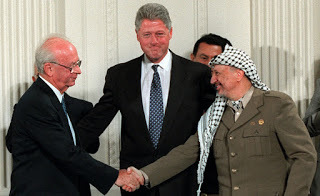 Yitzhak Rabin and Yasir Arafat with Pres. Clinton - the historic handshakeTwenty years ago, on November 4, 1995, Yitzhak Rabin, then Prime Minister of Israel, was assassinated at a peace rally in Tel Aviv by a religious extremist. On that day, the chance for peace between Israel and the Palestine territories suffered a setback from which it has never fully recovered. As violence in the Middle East again escalates, I bemoan this lost opportunity.
Yitzhak Rabin and Yasir Arafat with Pres. Clinton - the historic handshakeTwenty years ago, on November 4, 1995, Yitzhak Rabin, then Prime Minister of Israel, was assassinated at a peace rally in Tel Aviv by a religious extremist. On that day, the chance for peace between Israel and the Palestine territories suffered a setback from which it has never fully recovered. As violence in the Middle East again escalates, I bemoan this lost opportunity. In the early 1970’s when we lived in Israel, some of our Israeli friends told us that we were naïve. “Don’t you know that the Arabs only want to push us into the sea? You don’t know what it’s like.” At the time, they couldn't imagine Israel signing peace treaties with Egypt and Jordan yet that came to pass. How tragic that they were never proven wrong about peace with the Palestinians. Yet what are the choices if that never happens? Do they continue to have continued rounds of violence forever until they're ultimately destroyed by it?
I’ve often wondered since we returned to America if I would have continued to feel the same way about peace if we had stayed in Israel. Would we be part of the peace movement there or would the events there have caused us to think differently? After all, we’re shaped to a large extent by our experiences.
It’s impossible to know the answer to that question. From the vantage point of living here in America, however, I think that chances are better for peace with a two state solution than in a bi-national state. According to population statistics, if Israel retains the Palestinian areas, the Jewish Israeli population will be only 49% by 2020. Can Israel survive as a haven for Jews fleeing persecution in a bi-national state?
One state hasn’t worked for the Greek and Turkish Cypriots. Even the Czechs and Slovaks separated albeit peacefully. And rumblings of separatism from the Flemish and French have been heard in Belgium. Israel can learn from other countries’ historic mistakes. I mourn Yitzhak Rabin’s death twenty years ago and hope that Israelis and Palestinians and those of us hear can somehow revive what was begun and tragically aborted by Rabin's assassination. The future of peace depends on it.
Published on November 04, 2015 15:13



